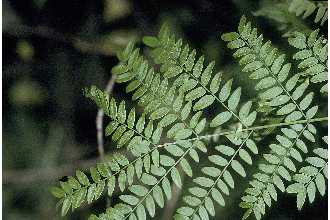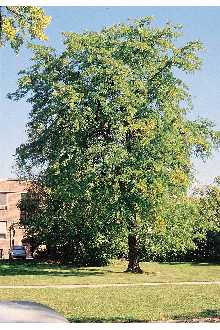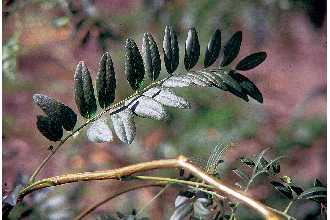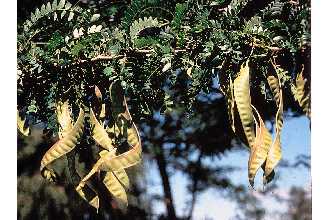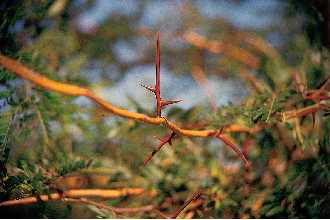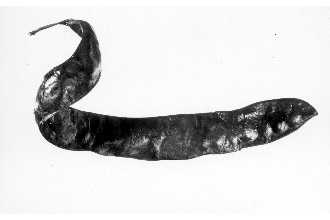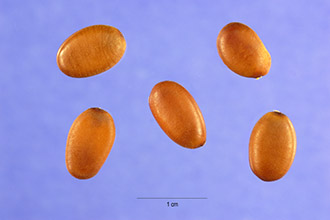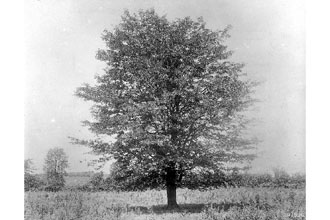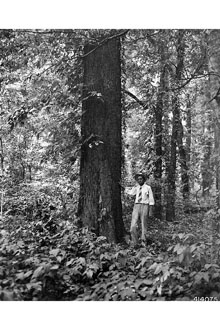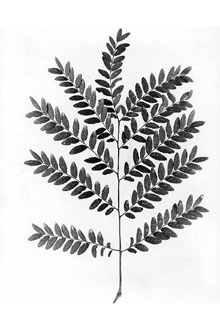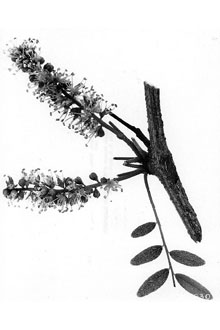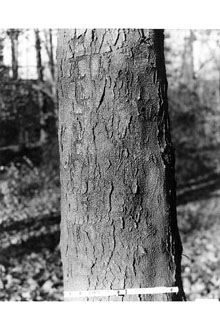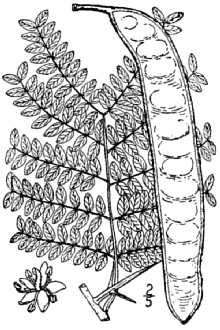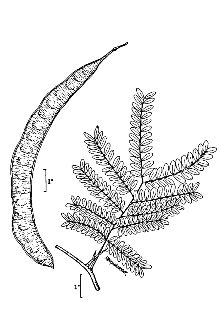Gleditsia triacanthos L. var. inermis (L.) C.K. Schneid.
Scientific Name: Gleditsia triacanthos L. var. inermis (L.) C.K. Schneid.

| General Information | |
|---|---|
| Usda Symbol | GLTRI |
| Group | Dicot |
| Life Cycle | Perennial |
| Growth Habits | ShrubTree, |
| Native Locations | GLTRI |
Plant Guide
Uses
Honey-locust is widely planted as a hardy and fast-growing ornamental. It is often used in extreme urban stress areas such as parking lot islands and sidewalk tree squares and has been planted for erosion control, for windbreaks and shelterbelts, and as a vegetation pioneer for rehabilitation of strip-mine spoil banks. Because of the small leaflets and open crown, the trees cast a light shade that permits shade-tolerant turfgrass and partial-shade perennials to grow underneath. Cultivars have been selected for crown shape and branch angles and leaf color, and most are both thornless and fruitless. Over-use of honey-locust in cities has led to recommendations that its use be discouraged until adequate biodiversity is restored. Honey-locust wood is dense, hard, coarse-grained, strong, stiff, shock-resistant, takes a high polish, and is durable in contact with soil. It has been used locally for pallets, crates, general construction, furniture, interior finish, turnery, firewood, railroad ties, and posts (fence posts may sprout to form living fences), but it is too scarce to be of economic importance. The wood also was formerly valued for bows. The geographic range of honey-locust probably was extended by Indians who dried the legumes, ground the dried pulp, and used it as a sweetener and thickener, although the pulp also is reported to be irritating to the throat and somewhat toxic. Fermenting the pulp can make a potable or energy alcohol. Native Americans sometimes ate cooked seeds, they have also been roasted and used as a coffee substitute. Honey-locust pods are eaten by cattle, goats, deer, opossum, squirrel, rabbits, quail, crows, and starling. White-tailed deer and rabbits eat the soft bark of young trees in winter, and livestock and deer eat young vegetative growth. Honey-locust is planted around wildlife plots and into pastures and hayfields to provide high-protein mast. Cattle do not digest the seeds, but sheep do.
Status
Please consult the PLANTS Web site and your State Department of Natural Resources for this plant’s current status, such as, state noxious status and wetland indicator values.
Description
General: Pea Family (Fabaceae). Native trees growing to 20 meters tall, with an open crown, armed with thick-branched thorns to 20 cm long on the main trunk and lower branches. Bark blackish to grayish-brown, with smooth, elongate, plate-like patches separated by furrows. Leaves are deciduous, alternate, pinnately or bipinnately compound, 10-20 cm long, often with 3-6 pairs of side branches; leaflets paired, oblong, 1-3 cm long, shiny and dark green above, turning a showy yellow in the fall, typically dropping early. Flowers are greenish-yellow, fragrant, small and numerous in hanging clusters 5-13 cm long, mostly either staminate (male) or pistillate (female), these usually borne on separate trees, but some perfect flowers (male plus female) on each tree (the species polygamo-dioecious). Fruits are flattened and strap-like pods 15-40 cm long and 2.5-3.5 cm wide, dark brown at maturity, pendulous and usually twisted or spiraled, with a sticky, sweet, and flavorful pulp separating the seeds; seeds beanlike, about 1 cm long. The common name "honey" is in reference to the sweet pulp of the fruits. Variation within the species: Gleditsia triacanthos var. inermis (L.) Schneid. (“inermis” means unarmed) is occasionally found wild, apparently more as a populational variant than what is generally given formal taxonomic status as a variety. Such trees have provided stock for selection of some the thornless horticultural forms, but most of the latter are actually derived from buds or stem cuttings taken from the upper, thornless portions of physiologically mature trees thorny in the lower portions. Scions taken from this area generally remain thornless. Breeders also can control the sex of scions by selecting unisexual budwood for cuttings. Certain branches bear only one type of flower, and trees from cuttings of those branches will bear only that type. Southern races of the species produce fruit more nutritious for stock feeding than northern races. Natural hybridization between honey-locust and water-locust (Gleditsia aquatica) produces Gleditsia X texana Sarg., the Texas honey-locust.
Distribution
Honey-locust is essentially Midwestern in distribution, from the west slope of Appalachians to the eastern edge of Great Plains -- scattered in the east-central US from central Pennsylvania westward to southeastern South Dakota, south to central and southeastern Texas, east to southern Alabama, then northeasterly through Alabama to western Maryland. Outlying populations occur in northwestern Florida, west Texas, and west central Oklahoma. It is naturalized east to the Appalachians from South Carolina north to Pennsylvania, New York, and New England and Nova Scotia; sometimes a weed tree in India, New Zealand, and South Africa. For current distribution, please consult the Plant Profile page for this species on the PLANTS Web site.
Establishment
Adaptation: Honey-locust occurs on well-drained sites, upland woodlands and borders, rocky hillsides, old fields, fence rows, river floodplains, hammocks, and rich, moist bottomlands. It is most commonly found on moist, fertile soils near streams and lakes. It is tolerant of flooding and also is drought-resistant and somewhat tolerant of salinity. On bottomlands, it is a pioneer tree. On limestone uplands, it is an invader of rocky glades and abandoned farm fields and pastures. It is generally found below 760 meters, but up to 1500 meters in a few places. Flowering: May-June; fruiting: September-October, sometimes remaining on the tree through February. General: Seed production begins on honey-locust trees at about 10 years and continues until about age 100, with optimum production at about 25-75 years of age. Some seed usually is produced every year but large crops usually occur every other year. The seeds are viable for long periods because of a thick, impermeable seed coat. Under natural conditions, individual seeds become permeable at different periods following maturation so that germination is spread over several years. The seeds are dispersed by birds and mammals, including cattle, which eat the fruits, and buffalo may have been historically important dispersal agents of the seeds. Germinability apparently is enhanced by passage through the digestive tract of animals. Honey-locust also reproduces from stump and root sprouts. Honey-locust is generally shade-intolerant and reproduction is primarily in open areas, gaps, and at the edges of woods. The ability of honey-locust to invade prairie and rangeland is thought to be related to its tolerance of xeric conditions. Growth is rapid and trees live to a maximum of about 125 years.
Management
The only serious disease of honey-locust is a canker, which is occasionally fatal, but trees in landscape plantings may be damaged by a number of pests and pathogens. Damage to young honey-locust also may be caused by rabbits gnawing the bark and by browsing of livestock and deer. Honey-locust is easily injured by fire because of its thin bark, but it sprouts after top-kill by fire. It appears to be excluded from prairies by frequent fire. Infrequent fires may create openings for reproduction in bottomland forests. Honey-locust is not a nitrogen fixer. Cultivars, Improved and Selected Materials (and area of origin) Contact your local Natural Resources
Conservation
Service (formerly Soil Conservation Service) office for more information. Look in the phone book under ”United States Government.” The Natural Resources Conservation Service will be listed under the subheading “Department of Agriculture.” These plant materials are readily available from commercial sources.
References
Blair, R,M, 1990, Gleditsia triacanthos, Pp, 358-364, IN: R,M, Burns and B,H, Honkala, Silvics of North America, Volume 2, Hardwoods, USDA Forest Service Agric, Handbook 654, Washington, D,C, Use soil moisture sensors to measure the soil moisture of Gleditsia triacanthos L. var. inermis (L.) C.K. Schneid.., <http://willow,ncfes,umn,edu/silvics_manual/Table_of_contents,htm> Dirr, M,A, 1974, Tolerance of honeylocust seedlings to soil-applied salts, Hortscience 9:53-54, Duke, J,A, 1983, Handbook of energy crops, Unpublished, Center for New Crops & Plant Products, Purdue University, West Lafayette, Indiana, <http://www,hort,purdue,edu/newcrop/duke_energy/Gleditsia_triacanthos,html> Gordon, D, 1966, A revision of the genus Gleditsia (Leguminosae), Ph,D, diss,, Indiana Univ,, Bloomington, Indiana, Halverson, H,G, & D,F, Potts 1981, Water requirements of honey locust (Gleditsia triacanthos f, inermis) in the urban forest, USDA Forest Service, Res, Pap, NE-487, Michener, D,C, 1986, Phenotypic instability in Gleditsia triacanthos (Fabaceae), Brittonia 38:360-361, Potts, D,F, & L,P, Herrington 1982, Drought resistance adaptations in urban honeylocust, J, Arboric, 8:75-80, Robertson, K,R, & Y,T, Lee 1976, The genera of Caesalpinioideae in the southeastern United States, J, Arnold Arbor, 57:1-34, Schnabel, A, & J,L, Hamrick 1995, Understanding the population genetic structure of Gleditsia triacanthos L,: The scale and pattern of pollen gene flow, Evolution 49:921-931, Smith, G,C, & E,G, Brennan 1984, Response of honeylocust cultivars to air pollution stress in an urban environment, J, Arboric, 10:289-293, Sullivan, J, 1994, Gleditsia triacanthos, IN: W,C, Fischer (compiler), The fire effects information system [database], USDA, Forest Service, Intermountain Research Station, Intermountain Fire Sciences Laboratory, Missoula, Montana, <http://www,fs,fed,us/database/feis/> USDA, NRCS 1993, Northeast wetland flora: Field office guide to plant species, Wetland Science Institute, Laurel, Maryland, Wilson, A,A, 1991, Browse agroforestry using honeylocust, Forestry Chronicle, 67:232-235,
Fact Sheet
Alternate Names
Honey–shucks, Sweet Locust, Three-thorned-acacia, Thorn tree, Thorny Locust, Sweet-bean
Uses
Landscaping Thornless and fruitless varieties have been developed by the horticultural industry and are used extensively in landscaping. The trees are very hardy and are often used in parking lot islands and along side walks. The open canopy and small leaves will not shade out turf grasses or other landscape plants.
Wildlife
Honey locust is used extensively by wildlife. The bean pods are a favorite food of the white-tailed deer, squirrels, rabbits, hogs, opossums, and raccoons. Domestic animals such as sheep, goats, and cattle will also forage on the honey locust bean pods. Browsing and grazing animals, such as deer, cattle, and sheep utilize the tender shoots in spring and the bark of young trees in winter. Honey locust is capable of forming dense thickets of thorny vegetation which provides excellent cover for a wide variety of game animals and birds. Flowers of this species are incredibly attractive to pollinating insects.
Timber
Wood from the honey locust is very dense, shock resistant and commonly used in the timber industry. Honey locust wood is easily split, capable of obtaining a high luster finish, and is durable when in contact with soil. For these reasons, timber from honey locust has been used as fence posts, railroad ties, furniture, warehouse or shipping pallets, tool handles and fuel.
Ethnobotanical
Native Americans used the dried pulp from the seed pods as a sweetening agent and a minor food source. The wood was used to make bows, and a variety of medicines were made from various parts of the plant.
Status
Please consult the PLANTS Web site and your State Department of Natural Resources for this plant’s current status (e.g. threatened or endangered species, state noxious status, and wetland indicator values).
Weediness
This plant may become weedy or invasive in some regions or habitats and may displace desirable vegetation if not properly managed. Please consult with your local NRCS Field Office, Cooperative Extension Service office, state natural resource, or state agriculture department regarding its status and use. Weed information is also available from the PLANTS Web site at plants.usda.gov. Please consult the Related Web Sites on the Plant Profile for this species for further information.
Description and Adaptation
Adaptation
Adaptation
Honey locust is a woody, long lived, native, deciduous, legume (Fabaceae family), and is capable of obtaining 100 feet in height. The doubly compound leaves are alternate and dark green in color. Large, red thorns are often found on the branches and trunk of wild trees. The thorns typically have 3 points, but may have more, especially those on the trunk. The bark is dark gray and black with deep fissures that form large “plates” of bark on mature trees. Long, twisted seed pods form in late summer, and turn from green to dark reddish brown as they mature. The size of these pods is highly variable, and they give off a very strong, sweet aroma when they ripen and fall to the ground. Honey locust is a pioneering woody species commonly found in overgrown pastures, fields, fence lines, and wood lot edges. It has a very broad range of adaptation, and is distributed nationwide, excluding Oregon and Washington. The greatest concentration of plants can be found in the central portions of the U.S. It prefers moist, fertile, alluvial soils. It will withstand periods of drought and prolonged wetness, and is commonly found in the upland areas along river drainages.
Establishment
This plant is often distributed by animals which have consumed the seed and passed them through their gut. This can be imitated by scarifying the seed mechanically or by using an acid bath. Seeds soaked in hot water (85 -90oC) and allowed to cool to room temperature have also germinated well. Seed that has been treated with these methods can be planted into a well prepared seed bed or container, approximately ½ inch deep. Seedling should be strong enough for transplanting at one year of age. Root cuttings have also been successfully used for propagation. Honey Locust requires full sun, and will not tolerate shading.
Management
Once established, trees are generally maintenance free, Pruning of lower limbs will encourage tall, upright growth, Use soil moisture sensors to measure the soil moisture of Gleditsia triacanthos L. var. inermis (L.) C.K. Schneid..,
Pests and Potential Problems
Honey Locust has few significant pests. Canker can sometimes be a problem, but rarely kills the tree. This plant can become a nuisance, and will dominate a site if left unchecked or mismanaged. Honey locust can produce numerous thorns that are capable of puncturing implement tires. Though not listed as a toxic plant, contact with thorns often results in sore wounds that are slow to heal.
Environmental Concerns
Due to rapid growth, aggressive re-sprouting, and density of the wood, this plant has excellent potential for use as a biofuel either by direct burning of the wood or cellulosic ethanol production.
Plant Traits
Growth Requirements
| Cold Stratification Required | No |
|---|---|
| Hedge Tolerance | None |
| Hedge Tolerance | Low |
| Frost Free Days, Minimum | 150 |
| Frost Free Days, Minimum | 150 |
| Fire Tolerance | Medium |
| Fire Tolerance | Medium |
| Fertility Requirement | Medium |
| Fertility Requirement | Low |
| Drought Tolerance | High |
| Drought Tolerance | High |
| Cold Stratification Required | No |
| Temperature, Minimum (°F) | -36 |
| CaCO3 Tolerance | Medium |
| CaCO3 Tolerance | Low |
| Anaerobic Tolerance | None |
| Anaerobic Tolerance | Low |
| Adapted to Medium Textured Soils | Yes |
| Adapted to Medium Textured Soils | Yes |
| Adapted to Fine Textured Soils | Yes |
| Adapted to Fine Textured Soils | Yes |
| Adapted to Coarse Textured Soils | No |
| Adapted to Coarse Textured Soils | No |
| Moisture Use | Medium |
| Temperature, Minimum (°F) | -30 |
| Shade Tolerance | Intolerant |
| Shade Tolerance | Intolerant |
| Salinity Tolerance | Medium |
| Salinity Tolerance | Medium |
| Root Depth, Minimum (inches) | 48 |
| Root Depth, Minimum (inches) | 20 |
| Precipitation, Minimum | 20 |
| Precipitation, Minimum | 20 |
| Precipitation, Maximum | 70 |
| Precipitation, Maximum | 70 |
| Planting Density per Acre, Minim | 170 |
| Planting Density per Acre, Minim | 108 |
| Planting Density per Acre, Maxim | 700 |
| Planting Density per Acre, Maxim | 700 |
| pH, Minimum | 5.0 |
| pH, Minimum | 4.8 |
| pH, Maximum | 8.0 |
| pH, Maximum | 8.0 |
| Moisture Use | Low |
Morphology/Physiology
| Active Growth Period | Spring and Summer |
|---|---|
| Toxicity | None |
| Toxicity | None |
| Shape and Orientation | Rounded |
| Fire Resistant | No |
| Foliage Texture | Medium |
| Foliage Texture | Fine |
| Foliage Porosity Winter | Porous |
| Foliage Porosity Winter | Moderate |
| Foliage Porosity Summer | Moderate |
| Foliage Porosity Summer | Dense |
| Foliage Color | Green |
| Foliage Color | Green |
| Flower Conspicuous | No |
| Flower Conspicuous | No |
| Flower Color | Yellow |
| Flower Color | Green |
| Resprout Ability | Yes |
| Fire Resistant | No |
| Fall Conspicuous | Yes |
| Fall Conspicuous | Yes |
| Coppice Potential | Yes |
| Coppice Potential | Yes |
| C:N Ratio | Medium |
| C:N Ratio | High |
| Bloat | None |
| Bloat | None |
| Active Growth Period | Spring and Summer |
| Shape and Orientation | Erect |
| Fruit/Seed Color | Green |
| Resprout Ability | Yes |
| Nitrogen Fixation | None |
| Nitrogen Fixation | None |
| Low Growing Grass | No |
| Low Growing Grass | No |
| Lifespan | Moderate |
| Lifespan | Moderate |
| Leaf Retention | No |
| Leaf Retention | No |
| Known Allelopath | No |
| Known Allelopath | No |
| Height, Mature (feet) | 70.0 |
| Height, Mature (feet) | 70.0 |
| Fruit/Seed Color | Brown |
| Fruit/Seed Conspicuous | Yes |
| Fruit/Seed Conspicuous | Yes |
| Growth Form | Single Crown |
| Growth Form | Single Stem |
| Growth Rate | Moderate |
| Growth Rate | Rapid |
| Height at 20 Years, Maximum (fee | 35 |
| Height at 20 Years, Maximum (fee | 35 |
Reproduction
| Propagated by Cuttings | Yes |
|---|---|
| Propagated by Seed | Yes |
| Propagated by Seed | Yes |
| Propagated by Sod | No |
| Propagated by Sod | No |
| Propagated by Sprigs | No |
| Propagated by Sprigs | No |
| Propagated by Tubers | No |
| Propagated by Tubers | No |
| Seed per Pound | 2800 |
| Fruit/Seed Period End | Fall |
| Seed per Pound | 2800 |
| Seed Spread Rate | Slow |
| Seed Spread Rate | Slow |
| Seedling Vigor | Medium |
| Seedling Vigor | Medium |
| Small Grain | No |
| Small Grain | No |
| Vegetative Spread Rate | None |
| Vegetative Spread Rate | None |
| Propagated by Corm | No |
| Propagated by Cuttings | Yes |
| Bloom Period | Late Spring |
| Bloom Period | Late Spring |
| Commercial Availability | Routinely Available |
| Commercial Availability | Routinely Available |
| Fruit/Seed Abundance | High |
| Fruit/Seed Abundance | Medium |
| Fruit/Seed Period Begin | Spring |
| Fruit/Seed Period Begin | Summer |
| Fruit/Seed Period End | Fall |
| Fruit/Seed Persistence | Yes |
| Propagated by Bare Root | Yes |
| Propagated by Bare Root | Yes |
| Propagated by Bulb | No |
| Propagated by Bulb | No |
| Propagated by Container | Yes |
| Propagated by Container | Yes |
| Propagated by Corm | No |
| Fruit/Seed Persistence | Yes |
Suitability/Use
| Palatable Browse Animal | Medium |
|---|---|
| Palatable Browse Animal | Medium |
| Palatable Graze Animal | Low |
| Palatable Graze Animal | Low |
| Palatable Human | No |
| Palatable Human | No |
| Post Product | Yes |
| Post Product | Yes |
| Protein Potential | Low |
| Pulpwood Product | No |
| Pulpwood Product | Yes |
| Veneer Product | No |
| Veneer Product | No |
| Nursery Stock Product | Yes |
| Nursery Stock Product | No |
| Naval Store Product | No |
| Naval Store Product | No |
| Lumber Product | Yes |
| Lumber Product | Yes |
| Fuelwood Product | High |
| Fuelwood Product | High |
| Fodder Product | No |
| Fodder Product | No |
| Christmas Tree Product | No |
| Christmas Tree Product | No |
| Berry/Nut/Seed Product | No |
| Berry/Nut/Seed Product | No |

